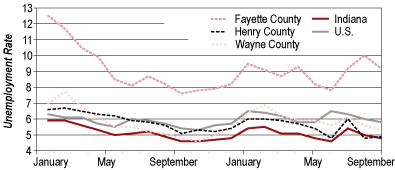Richmond
Professor of Economics and Director, Center for Economic Education, Indiana University East, Richmond
The Richmond-Connersville-New Castle (RCNC) area economy can expect a rebound in 2004. Business activity will pick up from its current lackluster performance. This is predicated upon national economic performance, which, in turn, will influence the local economy.
The recession of 2001 meant the usual cutbacks and closings in manufacturing. The manufacturing sector is still experiencing soft demands, especially in the automobile and technology industries. However, other firms producing components to the housing, pet, plastic, and casket industries have strong demands even in the wake of the Iraq war.
Manufacturing firms tend to make their largest “job-destruction” decisions during economic downturns. Job losses from contracting establishments rose sharply while job gains from expanding establishments fell sharply. The net result of these two gross flows moving in opposite directions is the loss of jobs during the recession-recovery period.
The September 2003 figures released by the Indiana Department of Workforce Development show that the unemployment rates in Wayne, Fayette, and Henry counties, were 5.3 percent, 9.2 percent, and 4.9 percent, respectively (see Figure 1). These unemployment rates were higher than the state rate of 4.8 percent, but lower than the national rate of 5.8 percent, with the exception of Fayette County, which is intricately tied to the automobile industry.
Figure 1
Unemployment Comparisons, January 2002 to September 2003

Despite nearly two years of steady gains in U.S. production and income, total employment is still below the peak of the previous business cycle in March 2001. Manufacturing jobs seem particularly vulnerable, having declined by roughly 13 percent since the recession began. As U.S. firms adjust to import competition from low-wage companies, they increase plant capacity and hire skilled workers. Consequently, there is increased productivity, which also translates into worker displacement because it takes fewer workers to produce the same output. The current jobless recovery may be due to structural, rather than cyclical, changes and RCNC is not immune to it.
Unlike manufacturing, the housing sector is doing extremely well. Home sales have surpassed last year’s. There is strong demand for new homes, priced between $160,000 and $170,000, especially in the southeast quadrant of Richmond and Centerville. The local median price of a home is $90,000, compared to the nation’s $177,000. Housing affordability is increasing because of low interest rates. At the end of October 2003, local financial institutions offered rates of 5.38 percent, 6.06 percent, and 3.91 percent, respectively, for fifteen-year, thirty-year, and one-year adjustable mortgages. These rates were much lower than last year’s and, along with the tax cuts, are boosting consumption and investment. In Richmond, there were 1,448 permits with an estimated investment value of $39 million. Large commercial construction projects were undertaken by Reid Hospital and Health Care Services, Richmond Community Schools, Old National Bank, and First Bank Richmond.
The nonmanufacturing sector, including services, retail/wholesale trade, and government, is expected to have moderate growth. It is important to note that this sector accounts for most of the total employment in RCNC. Rising employment in some industries (such as health care, education, and food) will offset job losses in the manufacturing sector. Also, successful business prospects, negotiated by the Economic Development Corporation of Wayne County, will help in job creation. The prospects are Richland, Osborn International, and Contract Industrial Tooling. These firms will bring good-paying jobs to Richmond.
As the national economic expansion continues, it will have a positive effect on RCNC in terms of employment, income, and growth provided there are no adverse external shocks or heightened geopolitical uncertainties.
Also in this Issue…
- Outlook for 2004
- The U.S. Economy
- The International Economy
- Financial Forecast
- Corporate Governance and Reporting
- Housing
- Indiana
- Anderson
- Bloomington
- Columbus
- Evansville
- Fort Wayne
- Gary
- Indianapolis
- Kokomo
- Lafayette
- Muncie
- New Albany
- Richmond
- South Bend/Mishawaka and Elkhart/Goshen
- Terre Haute
- Outlook Summary for 2004



